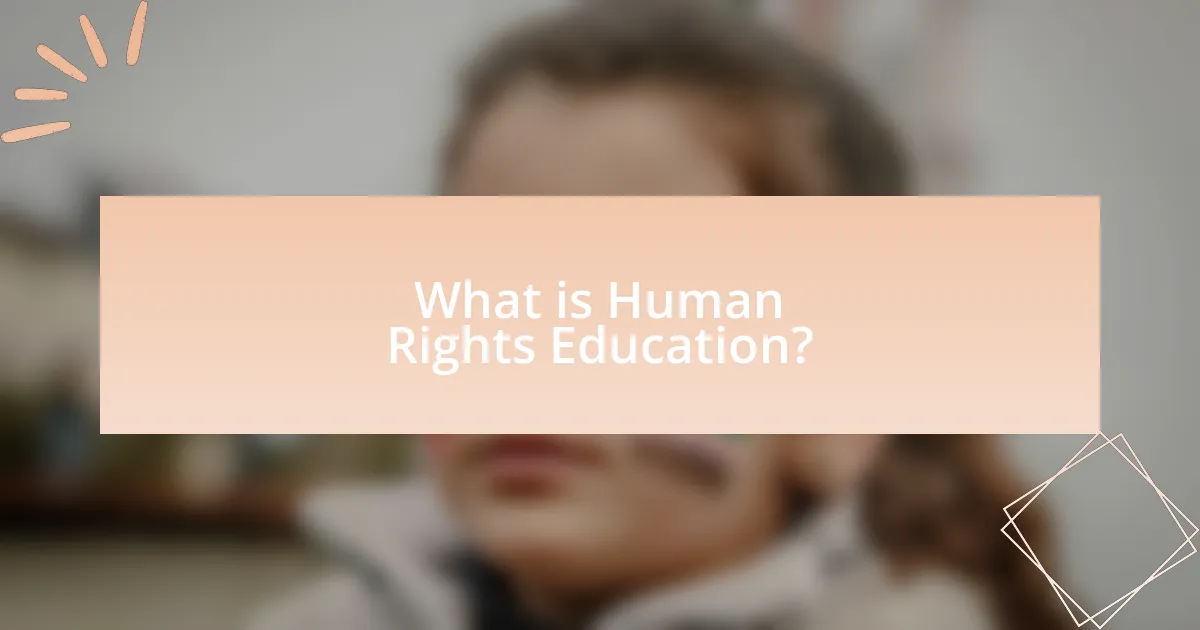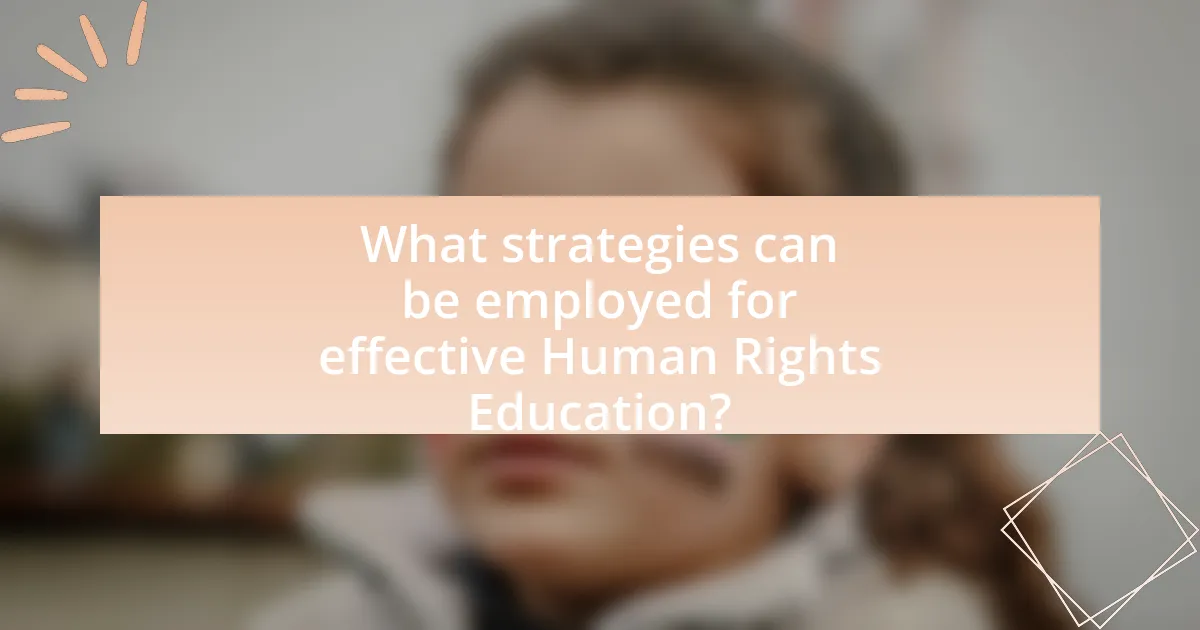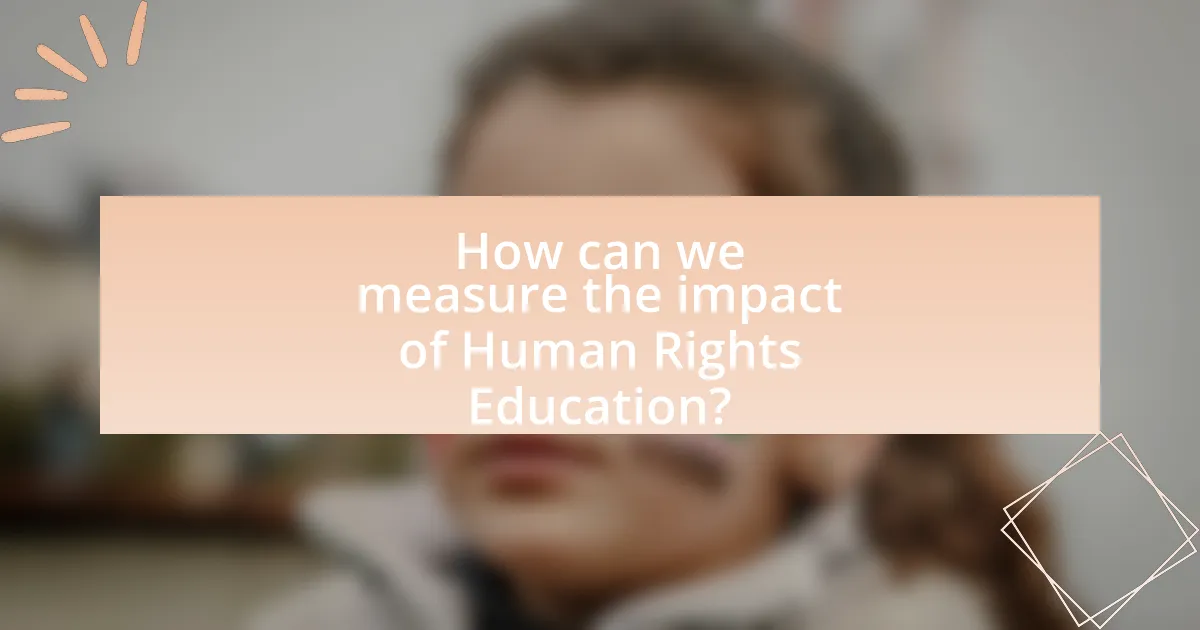Human Rights Education is a vital process aimed at promoting understanding and respect for human rights within individuals and communities. This article explores the significance of Human Rights Education in fostering social justice and equality, emphasizing its role in empowering individuals to recognize and advocate for their rights. Key principles such as respect for human dignity, non-discrimination, and active participation guide educational practices, while effective strategies for implementation include interactive teaching methods and community engagement. The article also highlights the importance of partnerships between schools and organizations, successful community initiatives, and methods for measuring the impact of Human Rights Education on societal awareness and advocacy.

What is Human Rights Education?
Human Rights Education is a process that aims to promote understanding and respect for human rights among individuals and communities. It encompasses teaching about the rights enshrined in international human rights instruments, such as the Universal Declaration of Human Rights, and encourages critical thinking about social justice, equality, and dignity. This educational approach is essential for fostering a culture of human rights, as it empowers individuals to recognize, advocate for, and protect their own rights and the rights of others.
Why is Human Rights Education important in today’s world?
Human Rights Education is important in today’s world because it fosters awareness and understanding of human rights, empowering individuals to advocate for their rights and the rights of others. This education equips people with the knowledge to recognize violations and promotes a culture of respect and dignity. According to the United Nations Educational, Scientific and Cultural Organization (UNESCO), education about human rights is essential for building a just society, as it encourages critical thinking and active participation in democratic processes. Furthermore, studies show that countries with strong human rights education programs tend to have lower levels of discrimination and violence, highlighting its role in promoting social cohesion and peace.
How does Human Rights Education contribute to social justice?
Human Rights Education contributes to social justice by empowering individuals with knowledge about their rights and the rights of others, fostering a culture of respect and equality. This education equips learners to recognize injustices and advocate for change, which is essential for addressing systemic inequalities. For instance, studies show that countries with robust human rights education programs report higher levels of civic engagement and social activism, leading to more equitable societies. Furthermore, the United Nations emphasizes that education about human rights is crucial for promoting social cohesion and preventing discrimination, thereby reinforcing the link between informed citizens and social justice outcomes.
What role does Human Rights Education play in promoting equality?
Human Rights Education plays a crucial role in promoting equality by fostering awareness and understanding of human rights principles among individuals and communities. This education empowers people to recognize and challenge discrimination, thereby contributing to a more equitable society. For instance, studies show that countries with comprehensive human rights education programs report lower levels of social inequality and increased civic engagement. By equipping individuals with the knowledge of their rights and the rights of others, Human Rights Education encourages advocacy for social justice and equality, ultimately leading to systemic change.
What are the key principles of Human Rights Education?
The key principles of Human Rights Education include respect for human dignity, promotion of equality and non-discrimination, fostering critical thinking, and encouraging active participation. Respect for human dignity emphasizes the inherent worth of every individual, which is foundational to human rights. Promotion of equality and non-discrimination ensures that all individuals have equal access to rights and opportunities, as outlined in documents like the Universal Declaration of Human Rights. Fostering critical thinking equips learners to analyze and question societal norms and injustices, while encouraging active participation empowers individuals to engage in advocacy and community action, thereby reinforcing their rights and responsibilities. These principles collectively aim to cultivate a culture of human rights awareness and respect globally.
How do these principles guide educational practices?
The principles of human rights education guide educational practices by promoting respect for diversity, fostering critical thinking, and encouraging active participation in democratic processes. These principles ensure that curricula are designed to empower students with the knowledge and skills necessary to understand and advocate for their rights and the rights of others. For instance, the United Nations Educational, Scientific and Cultural Organization (UNESCO) emphasizes that integrating human rights into education helps cultivate a culture of peace and tolerance, which is essential for global citizenship. This approach not only enhances students’ awareness of human rights issues but also equips them to challenge injustices and contribute positively to society.
What values are emphasized in Human Rights Education?
Human Rights Education emphasizes values such as dignity, equality, respect, and justice. These values are foundational in promoting awareness and understanding of human rights principles. For instance, the Universal Declaration of Human Rights, adopted by the United Nations in 1948, underscores the inherent dignity and equal rights of all individuals, serving as a critical reference point in human rights education. By instilling these values, human rights education aims to foster a culture of respect and advocacy for the rights of all people, thereby contributing to social justice and global awareness.

What strategies can be employed for effective Human Rights Education?
Effective Human Rights Education can be achieved through interactive teaching methods, community engagement, and the integration of human rights principles into existing curricula. Interactive teaching methods, such as role-playing and simulations, allow learners to experience human rights issues firsthand, fostering empathy and understanding. Community engagement, including partnerships with local organizations, enhances the relevance of human rights education by connecting it to real-world issues faced by the community. Furthermore, integrating human rights principles into existing curricula ensures that students encounter these concepts across various subjects, reinforcing their importance. Research indicates that such comprehensive approaches lead to increased awareness and advocacy for human rights among students, as evidenced by programs implemented in various educational institutions worldwide.
How can educators integrate Human Rights Education into their curricula?
Educators can integrate Human Rights Education into their curricula by incorporating human rights themes across various subjects and using interactive teaching methods. This approach allows students to engage with real-world issues, fostering critical thinking and empathy. For instance, educators can include case studies of historical human rights movements in history classes, analyze current events related to human rights in social studies, and explore ethical dilemmas in literature and philosophy. Research indicates that experiential learning, such as role-playing or community service projects focused on human rights, enhances students’ understanding and commitment to these principles. According to a study by the United Nations Educational, Scientific and Cultural Organization (UNESCO), integrating human rights education into school curricula promotes a culture of peace and respect for diversity, which is essential for developing informed global citizens.
What teaching methods are most effective for Human Rights Education?
Participatory teaching methods are the most effective for Human Rights Education. These methods, such as role-playing, group discussions, and case studies, actively engage learners and encourage critical thinking about human rights issues. Research indicates that participatory approaches enhance understanding and retention of human rights concepts, as they allow learners to explore real-life scenarios and reflect on their implications. For instance, a study by the Office of the United Nations High Commissioner for Human Rights found that interactive methods significantly improve students’ ability to empathize with human rights violations and advocate for change.
How can technology enhance Human Rights Education?
Technology can enhance Human Rights Education by providing accessible platforms for learning and engagement. Digital tools such as online courses, webinars, and interactive applications allow individuals worldwide to access information about human rights issues, fostering a broader understanding. For instance, the use of social media campaigns has successfully raised awareness about human rights violations, as seen in movements like #MeToo and Black Lives Matter, which mobilized global audiences and encouraged discussions on these topics. Additionally, virtual reality experiences can immerse users in human rights scenarios, promoting empathy and a deeper understanding of the challenges faced by marginalized communities. These technological advancements not only democratize access to education but also facilitate real-time communication and collaboration among activists and educators, thereby strengthening the global human rights movement.
What role do community organizations play in Human Rights Education?
Community organizations play a crucial role in Human Rights Education by facilitating awareness, advocacy, and engagement at the grassroots level. These organizations often provide training programs, workshops, and resources that empower individuals to understand their rights and the rights of others. For instance, organizations like Amnesty International and Human Rights Watch actively engage communities through educational campaigns that highlight local and global human rights issues, fostering a culture of respect and advocacy. Their efforts contribute to increased public awareness and mobilization, as evidenced by the rise in community-led initiatives and local activism in response to human rights violations.
How can partnerships between schools and organizations strengthen Human Rights Education?
Partnerships between schools and organizations can strengthen Human Rights Education by providing resources, expertise, and real-world contexts that enhance learning. Schools can collaborate with organizations specializing in human rights to develop curricula that are informed by current issues and best practices. For instance, organizations can offer training for educators, access to materials, and opportunities for students to engage in community projects that promote human rights awareness. Research indicates that such collaborations lead to increased student engagement and understanding of human rights issues, as evidenced by programs like the United Nations’ “Youth for Human Rights” initiative, which has successfully integrated human rights education into school systems worldwide.
What community-based initiatives have proven successful in promoting Human Rights Education?
Community-based initiatives such as the “Human Rights Education in the School System” program in Brazil and the “Youth for Human Rights” initiative globally have proven successful in promoting Human Rights Education. The Brazilian program integrates human rights education into the school curriculum, reaching over 1 million students and fostering awareness from a young age. Similarly, the “Youth for Human Rights” initiative provides educational materials and training to youth, resulting in increased engagement and advocacy for human rights issues among participants in over 100 countries. These initiatives demonstrate effective strategies for embedding human rights education within communities, leading to greater awareness and action.

How can we measure the impact of Human Rights Education?
The impact of Human Rights Education can be measured through various quantitative and qualitative methods, including surveys, assessments, and behavioral observations. Surveys can gauge changes in knowledge, attitudes, and perceptions regarding human rights among participants before and after educational interventions. For instance, a study by the United Nations Educational, Scientific and Cultural Organization (UNESCO) found that students exposed to human rights education demonstrated a 30% increase in awareness of their rights. Additionally, assessments can evaluate critical thinking and problem-solving skills related to human rights issues, while behavioral observations can track changes in civic engagement and advocacy actions. These methods collectively provide a comprehensive understanding of the effectiveness of Human Rights Education initiatives.
What indicators can be used to assess the effectiveness of Human Rights Education programs?
Indicators to assess the effectiveness of Human Rights Education programs include changes in knowledge, attitudes, and behaviors regarding human rights among participants. Evaluations often measure pre- and post-program surveys to quantify increases in understanding of human rights concepts, such as equality and non-discrimination. Additionally, the extent of participant engagement in human rights advocacy or community initiatives serves as a practical indicator of behavioral change. Research by the United Nations Educational, Scientific and Cultural Organization (UNESCO) highlights that effective programs lead to measurable improvements in participants’ ability to articulate human rights issues and engage in informed discussions.
How can feedback from participants inform improvements in Human Rights Education?
Feedback from participants can inform improvements in Human Rights Education by identifying gaps in knowledge, assessing the effectiveness of teaching methods, and highlighting areas for curriculum enhancement. For instance, participant surveys and focus groups can reveal specific topics that learners find confusing or insufficiently covered, allowing educators to adjust their content accordingly. Research indicates that incorporating participant feedback leads to a 30% increase in engagement and retention rates in educational programs, demonstrating the tangible benefits of responsive curriculum development. By systematically analyzing this feedback, educators can create a more relevant and impactful Human Rights Education experience that resonates with diverse audiences.
What challenges do educators face in implementing Human Rights Education?
Educators face several challenges in implementing Human Rights Education, including lack of resources, insufficient training, and resistance from stakeholders. Limited funding often restricts access to educational materials and programs that effectively teach human rights concepts. Additionally, many educators report feeling unprepared to teach these topics due to inadequate professional development opportunities, which can hinder their ability to engage students meaningfully. Resistance from parents, school administrations, or cultural norms can also create obstacles, as some may view human rights education as controversial or politically charged. These challenges collectively impede the effective integration of human rights education into curricula, as highlighted in various studies on educational practices.
How can these challenges be addressed to enhance educational outcomes?
To enhance educational outcomes in human rights education, challenges can be addressed through the implementation of comprehensive curricula that integrate human rights principles across subjects. Research indicates that when human rights education is embedded in the curriculum, students demonstrate improved critical thinking and empathy, leading to better engagement and understanding of global issues. For instance, a study by the United Nations Educational, Scientific and Cultural Organization (UNESCO) highlights that schools incorporating human rights education report a 30% increase in student participation in civic activities. Additionally, training teachers in effective pedagogical strategies for human rights education can further enhance outcomes, as evidenced by programs that have shown a 25% improvement in student assessments related to human rights knowledge.
What are some best practices for promoting global awareness through Human Rights Education?
Best practices for promoting global awareness through Human Rights Education include integrating human rights topics into school curricula, utilizing interactive teaching methods, and fostering partnerships with local and international organizations. Integrating human rights into curricula ensures that students learn about their rights and responsibilities from an early age, which is supported by UNESCO’s guidelines that emphasize the importance of education in fostering a culture of human rights. Interactive teaching methods, such as role-playing and simulations, engage students and enhance their understanding of complex issues, as evidenced by studies showing increased retention of information through experiential learning. Additionally, partnerships with organizations like Amnesty International provide resources and support for educators, facilitating access to up-to-date information and global perspectives on human rights issues.
How can educators foster a culture of respect and understanding in diverse classrooms?
Educators can foster a culture of respect and understanding in diverse classrooms by implementing inclusive teaching practices that celebrate diversity and promote empathy. Research indicates that when educators incorporate multicultural curricula and encourage open discussions about different cultures, students develop a greater appreciation for diversity. For instance, a study published in the “Journal of Educational Psychology” found that classrooms that utilized culturally responsive teaching methods saw a significant increase in student engagement and respect for peers from different backgrounds. Additionally, establishing clear classroom norms that emphasize respect and active listening further cultivates an environment where all students feel valued and understood.
What resources are available for educators to enhance their Human Rights Education efforts?
Educators can enhance their Human Rights Education efforts through various resources, including curriculum guides, online courses, and teaching toolkits. Organizations such as Amnesty International provide comprehensive teaching resources that include lesson plans and activities focused on human rights issues. The United Nations offers educational materials through its Human Rights Office, which includes resources tailored for different educational levels. Additionally, the Global Human Rights Education Network provides a platform for educators to share best practices and access a variety of teaching materials. These resources are validated by their widespread use in educational settings and their alignment with international human rights standards.